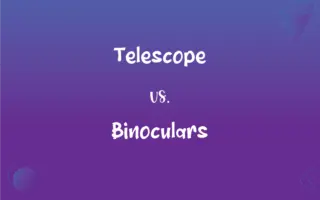True Solution vs. Colloidal Solution: What's the Difference?
Edited by Aimie Carlson || By Harlon Moss || Updated on October 28, 2023
A true solution is a homogenous mixture with uniformly distributed particles; a colloidal solution has intermediate-sized particles dispersed throughout but not settled.

Key Differences
A true solution and a colloidal solution are both mixtures, but they differ significantly in their particle sizes and properties. A true solution is a homogenous mixture where solute particles are dissolved completely, resulting in a clear and transparent mixture. In contrast, a colloidal solution consists of larger particles dispersed throughout a solvent, creating a mixture that can be cloudy or opaque.
In the realm of particle size, true solutions have the smallest particles, usually atoms, ions, or small molecules, which cannot be seen even under a microscope. On the other hand, colloidal solutions contain particles larger than those in true solutions but smaller than those in suspensions. These particles are typically in the range of 1 to 1000 nanometers and can be observed under an ultramicroscope.
Another distinguishing feature between a true solution and a colloidal solution lies in their ability to scatter light. A true solution does not scatter light, maintaining its transparency. A colloidal solution, due to its larger particle size, exhibits the Tyndall effect, where light passing through the solution gets scattered, producing a visible beam.
The stability of these solutions also varies. True solutions are generally stable, and particles do not separate out upon standing. In a colloidal solution, particles remain dispersed and don't settle at the bottom, but they might aggregate over time or under certain conditions, leading to coagulation or precipitation.
The filtration process distinguishes these solutions as well. In a true solution, solute particles pass through filter paper because of their tiny size. In a colloidal solution, particles are larger and cannot pass through standard filter paper but can move through membranes in processes like dialysis.
ADVERTISEMENT
Comparison Chart
Particle Size
Atoms, ions, or small molecules
1 to 1000 nanometers
Transparency
Transparent
Cloudy or opaque
Light Scattering
Does not scatter light
Exhibits the Tyndall effect
Stability
Stable; particles don't separate
Particles may aggregate over time
Filtration
Particles pass through filter paper
Particles retained by standard filter paper
ADVERTISEMENT
True Solution and Colloidal Solution Definitions
True Solution
Transparent and doesn't scatter light.
When you look through a true solution of blue copper sulfate, it remains clear blue.
Colloidal Solution
Particles are larger than in true solutions but don't settle.
Milk is a colloidal solution with fat globules dispersed in water.
True Solution
Has particles that pass through filter paper.
A true solution of dye in water can be filtered without residue.
Colloidal Solution
Particles remain dispersed and may aggregate over time.
A colloidal solution of clay in water can coagulate upon adding salt.
True Solution
Contains dissolved particles at the atomic or molecular level.
Sugar in water is a true solution with molecules evenly distributed.
Colloidal Solution
Contains particles dispersed throughout a medium.
Starch in water forms a colloidal solution.
True Solution
Stable and doesn't separate upon standing.
A true solution of alcohol in water remains mixed indefinitely.
Colloidal Solution
Can exhibit the Tyndall effect due to light scattering.
A beam of light passing through fog, a colloidal solution, becomes visible.
True Solution
A homogeneous mixture of solute and solvent.
Salt dissolved in water forms a true solution.
Colloidal Solution
Particles cannot pass through standard filter paper.
Gelatin in water, a colloidal solution, remains on the filter paper during filtration.
FAQs
Can the solute be separated from a true solution by filtration?
No, the solute particles in a true solution are too small to be separated by ordinary filtration.
Is a true solution transparent?
Yes, a true solution is transparent and allows light to pass through without scattering.
Do colloids exhibit osmotic pressure?
Yes, colloids can exhibit osmotic pressure, though it is generally lower than that of true solutions.
How can colloidal solutions be prepared?
Colloidal solutions can be prepared by methods like condensation (building up of smaller particles) or dispersion (breaking down larger particles).
Do true solutions show the Tyndall effect?
No, true solutions do not show the Tyndall effect as they do not scatter light.
Are true solutions stable?
Yes, true solutions are stable and the solute particles do not settle down.
What is an example of a true solution?
Salt water is a common example of a true solution.
How is the concentration of a true solution measured?
Concentration can be measured in terms such as molarity, molality, or mass percent.
Do true solutions exhibit osmotic pressure?
Yes, true solutions can exhibit osmotic pressure.
What is a colloidal solution?
A colloidal solution, or colloid, is a heterogeneous mixture in which the solute particles are intermediate in size between true solutions and suspensions.
Can colloidal particles be seen with the naked eye?
No, colloidal particles are too small to be seen with the naked eye but are larger than molecules.
Do colloidal solutions show the Tyndall effect?
Yes, colloidal solutions show the Tyndall effect because they scatter light.
Are colloidal solutions stable?
Colloidal solutions are relatively stable, but they can be destabilized under certain conditions.
Can colloidal particles be separated by ordinary filtration?
No, colloidal particles cannot be separated by ordinary filtration but can be separated by ultrafiltration.
Can the properties of solute be observed in a true solution?
No, the properties of the solute are completely masked in a true solution.
How can colloids be classified?
Colloids can be classified based on the phase of dispersed medium and dispersion medium, e.g., foam (gas in liquid) or sol (solid in liquid).
What is an example of a colloidal solution?
Milk is a common example of a colloidal solution.
What is a true solution?
A true solution is a homogenous mixture of two or more substances where the solute particles are of atomic or molecular size.
How do solute particles move in a true solution?
Solute particles move freely and continuously in a true solution due to Brownian motion.
What is the movement of colloidal particles called?
The movement of colloidal particles is called Brownian motion.
About Author
Written by
Harlon MossHarlon is a seasoned quality moderator and accomplished content writer for Difference Wiki. An alumnus of the prestigious University of California, he earned his degree in Computer Science. Leveraging his academic background, Harlon brings a meticulous and informed perspective to his work, ensuring content accuracy and excellence.
Edited by
Aimie CarlsonAimie Carlson, holding a master's degree in English literature, is a fervent English language enthusiast. She lends her writing talents to Difference Wiki, a prominent website that specializes in comparisons, offering readers insightful analyses that both captivate and inform.






































































